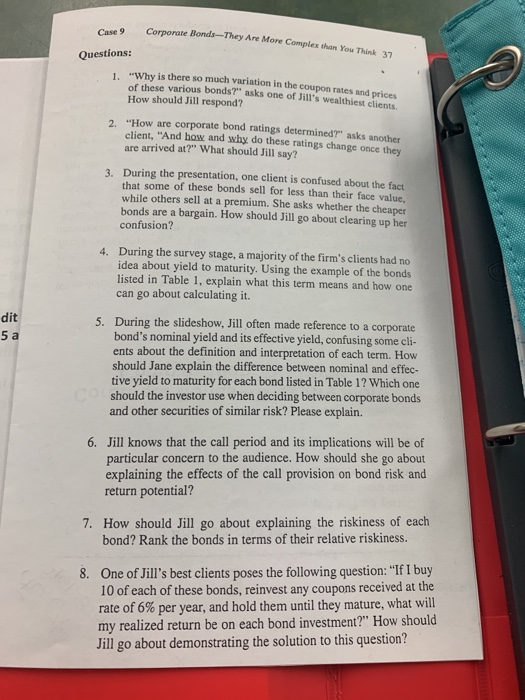
e Corporate Bonds-They Are More Complex than You Think 37 Questions: Why is there so much variation in the coupon rates and prices of these various bonds Tasks one of Jill's wealthiest clients How should Jill respond? 2. "How are corporate bond ratings determined tasks another client, "And how and why do these ratings change once they are arrived at?" What should Jill say? 3. During the presentation, one client is confused about the fact that some of these bonds sell for less than their face value, while others sell at a premium. She asks whether the cheaper bonds are a bargain. How should Jill go about clearing up her confusion? 4. During the survey stage, a majority of the firm's clients had no idea about yield to maturity. Using the example of the bonds listed in Table 1, explain what this term means and how one can go about calculating it. dit 5 a 5. During the slideshow, Jill often made reference to a corporate bond's nominal yield and its effective yield, confusing some cli- ents about the definition and interpretation of each term. How should Jane explain the difference between nominal and effec- tive yield to maturity for each bond listed in Table 1? Which one should the investor use when deciding between corporate bonds and other securities of similar risk? Please explain. 6. Jill knows that the call period and its implications will be of particular concern to the audience. How should she go about explaining the effects of the call provision on bond risk and return potential? 7. How should Jill go about explaining the riskiness of each bond? Rank the bonds in terms of their relative riskiness. 8. One of Jill's best clients poses the following question: "If I buy 10 of each of these bonds, reinvest any coupons received at the rate of 6% per year, and hold them until they mature, what will my realized return be on each bond investment?" How should Jill go about demonstrating the solution to this question? 3. During the presentation, one client is confused about the fact that some of these bonds sell for less than their face value, while others sell at a premium. She asks whether the cheaper bonds are a bargain. How should Jill go about clearing up her confusion








